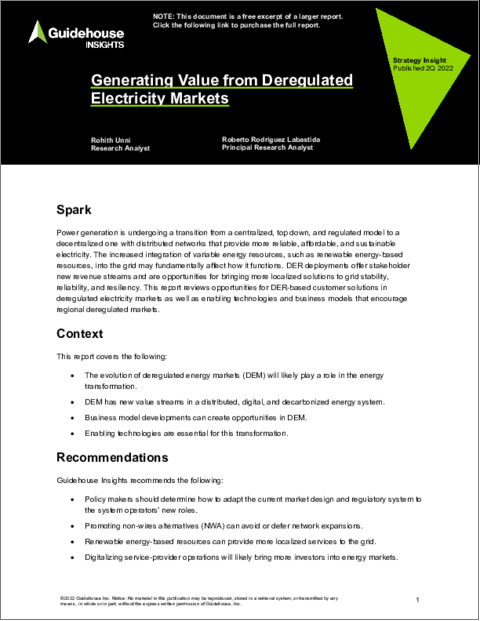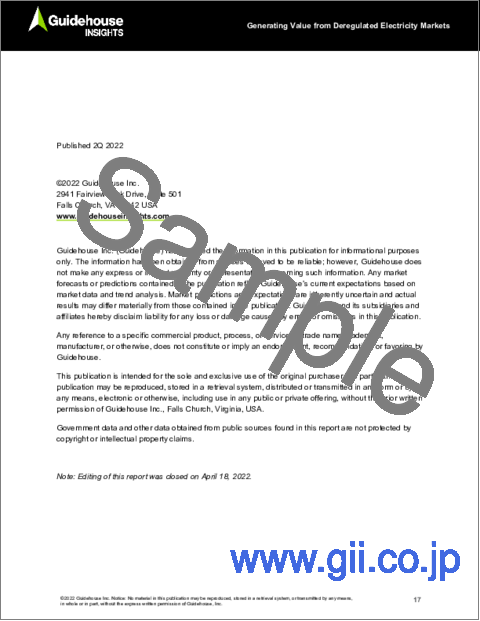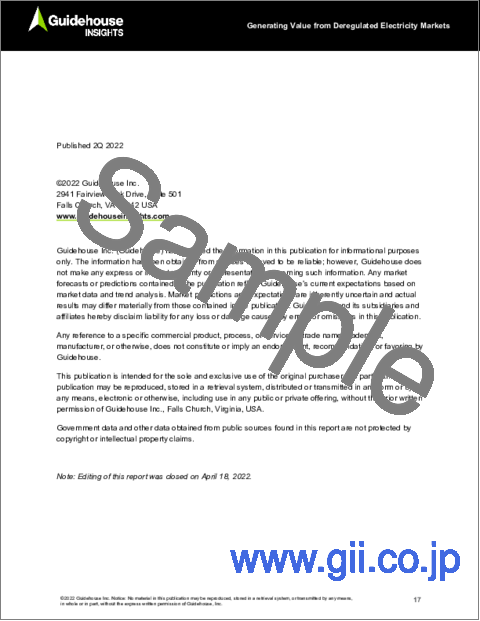|
|
市場調査レポート
商品コード
1070453
規制緩和された電力市場からの価値創出Generating Value from Deregulated Electricity Markets |
||||||
| 規制緩和された電力市場からの価値創出 |
|
出版日: 2022年04月19日
発行: Guidehouse Insights
ページ情報: 英文 17 Pages; 4 Tables, Charts & Figures
納期: 即納可能
|
- 全表示
- 概要
- 図表
- 目次
発電は、集中型、トップダウン型、規制型のモデルから、より信頼性が高く、安価で持続可能な電力を供給する分散型ネットワークを備えた分散型モデルへの移行が進んでいます。
再生可能エネルギーをベースとする資源などの可変エネルギー資源のグリッドへの統合が進むと、その機能に根本的な影響を与える可能性があります。分散型エネルギー資源(DER)の導入は、ステークホルダーに新しい収入源を提供し、グリッドの安定性、信頼性および回復力によりローカライズされたソリューションをもたらす機会でもあります。
当レポートでは、規制緩和された電力市場を調査し、分散型エネルギー資源(DER)の機会の概要、グリッドに対するシステム運用者とさまざまな分散型エネルギー資源(DER)サービスの役割の変化などの情報を提供しています。
目次
序文
背景
提言
規制された電力市場と規制緩和された電力市場の相違
拡大しているシステムオペレーターの役割
規制緩和された電力市場の鍵であるDERサービス
DEMは魅力的なビジネスモデルを要求
- バンドルソリューションはEnergy as a Serviceを奨励
- BESSベースの価格裁定とピーク回避は消費者のバリューストリームを提供
- DERアグリゲーター
- 利益を生むエネルギーコミュニティ
- サービスが十分ではないコミュニティを従量課金ソフトウェアモデルが支援
DERの市場への参加が利害関係者の価値を高める
- BTM BESSは前日およびリアルタイムの電力市場に参加
- デマンドレスポンスは容量市場でサービスを提供
- EVはアンシラリーサービス市場とV2Gアプリケーションで可能性を提示
- DERはアグリゲーターとエネルギー小売業者に価値を付加
DEMは実現技術が必要
- グリッドオペレーターの機会を拡大
- エネルギー小売業者はデジタル化の進展により付加価値を向上
- アグリゲーターは容量と補助市場へのエンドユーザーの参加を可能にする
すべての利害関係者が適応策を決定する必要がある
LIST OF CHARTS AND FIGURES
- REM vs. DEM
- Flexibility Service for Deregulated Energy Markets
LIST OF TABLES
- TSO-DSO Coordination Scheme
- DER and Their Services
Power generation is undergoing a transition from a centralized, top down, and regulated model to a decentralized one with distributed networks that provide more reliable, affordable, and sustainable electricity. The increased integration of variable energy resources, such as renewable energy-based resources, into the grid may fundamentally affect how it functions. distributed energy resources (DER) deployments offer stakeholders new revenue streams, and are opportunities for bringing more localized solutions to grid stability, reliability, and resiliency. Equally important, DER also offer multiple new revenue streams to stakeholders.
Introducing competition into electricity markets removes centralized control and allows the entry of independent power producers. In these markets, players no longer have responsibility for supplying power to all consumers, but can decide how to maximize their profit potential. Efficient coordination between transmission system operators (TSO) and distribution system operators (DSO) can enable increased participation of DER and aggregators in the wholesale electricity market. In addition to providing energy services, a DSO acts as a platform to exchange data between a TSO and DER or aggregators.
This Guidehouse Insights report provides an overview of DER opportunities in deregulated energy markets. It explores the changing role of system operators and various DER services to the grid. Additionally, it examines how DER owners can create multiple value streams using various business models and by participating in different markets. It also covers the enabling digitalized platforms that encourage stakeholder participation in the market.
KEY QUESTIONS ADDRESSED:
- What is the fundamental difference between a deregulated energy market and a regulated energy market?
- How do the system operators' roles vary in the changing market paradigm?
- What are the services provided by DER?
- Which are the various business models that attract DER owners?
- How does market participation provide different value streams to the stakeholders?
- How do digital platforms encourage DER participation in deregulated markets?
WHO NEEDS THIS REPORT:
- DER technology developers and manufacturers
- Energy storage technology firms
- Microgrid controls and software companies
- Renewable energy development financing companies
- Government and regulatory agencies
- Utilities
- Investor community
- Energy retailers, aggregators, and system operators
TABLE OF CONTENTS
Spark
Context
Recommendations
Regulated and Deregulated Electricity Markets Differ
System Operators' Roles Are Expanding
DER Services Are Key to a Deregulated Electricity Market
DEM Demands Attractive Business Models
- Bundled Solutions Encourage Energy as a Service
- BESS-based Price Arbitrage and Peak Avoidance Provide Consumer Value Streams
- DER Aggregators
- Energy Communities Can Show Profits
- Pay as You Go Models Assist Underserved Communities
DER Participation in the Market Increases Stakeholders' Value
- BTM BESS Participates in Day-ahead and Real-time Electricity Markets
- Demand Response Offers Services in the Capacity Market
- EVs Show Potential in the Ancillary Service Market and V2G Applications
- DER Adds Value to Aggregators and Energy Retailers
DEM Needs Enabling Technologies
- Grid Operators Have Enhanced Opportunities
- Energy Retailers Add Value with Increased Digitalization
- Aggregators Enable End-User Participation in Capacity and Ancillary Markets




